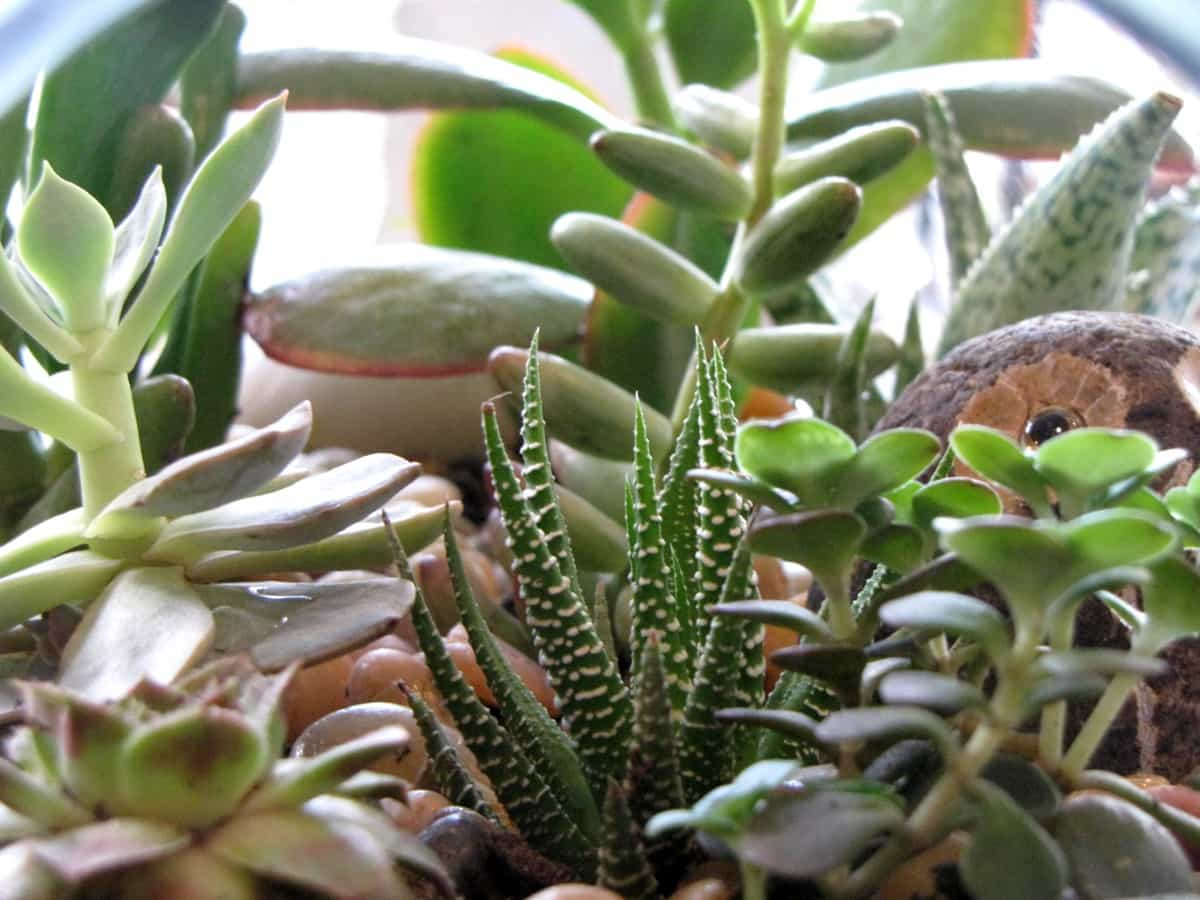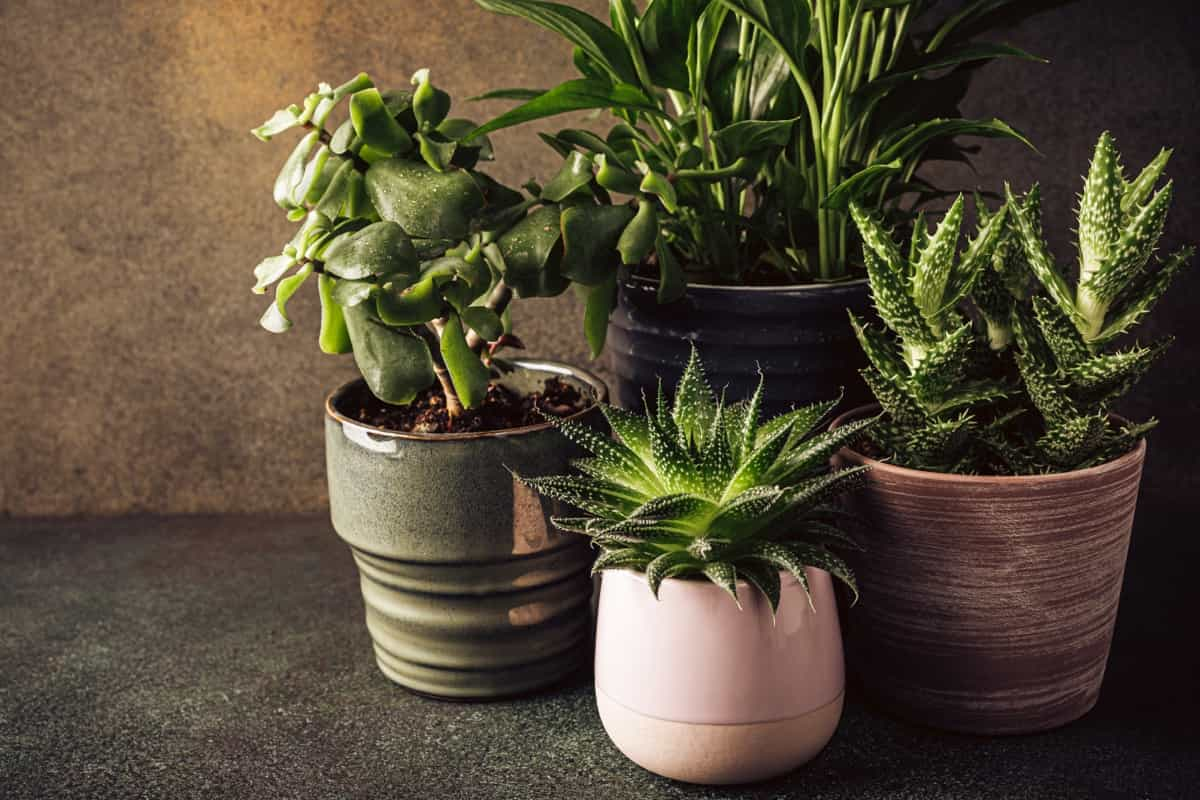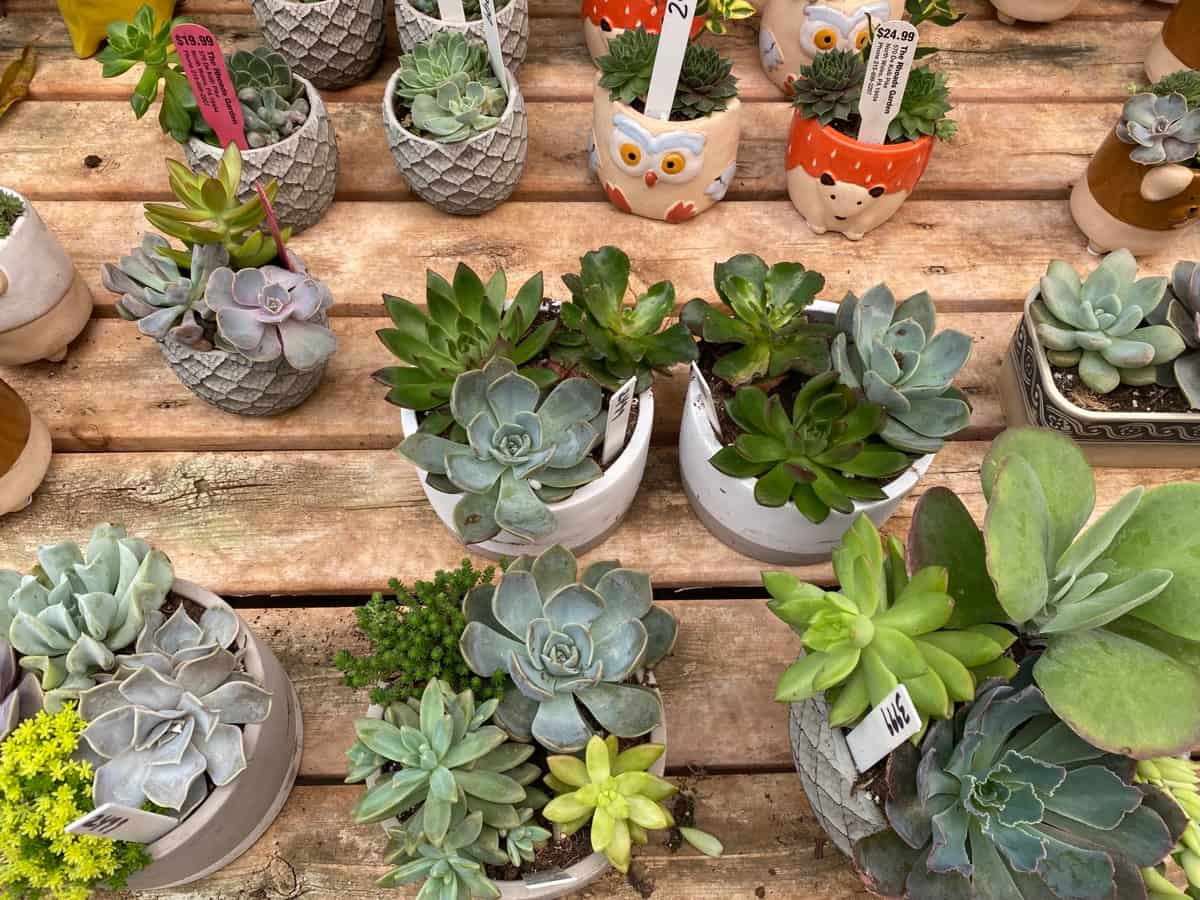Succulents are the perfect addition to any home or garden. However, one common problem that succulents face is powdery mildew. Powdery mildew can damage your succulents if not treated quickly and effectively. Maintaining the health and beauty of succulent plants can be a fulfilling hobby, but it is important to remember that they are also susceptible to diseases such as powdery mildew. Keeping your succulents spaced correctly, providing adequate ventilation and sunlight, and using preventative sprays are all effective methods for preventing or treating this issue.

How to Identify and Treat Powdery Mildew on Succulent Plants
What is Powdery Mildew?
The fungi responsible for powdery mildew feed on the surface cells of the plant’s leaves stems, and flowers. This feeding causes infected areas to appear as if they are covered in a white or grayish powder. The fungal spores can easily spread from one plant to another through the air or by contact with contaminated objects like gardening tools. Once established on a plant, powdery mildew can quickly spread and cause significant damage.
Unlike other fungi that thrive in wet conditions, powdery mildew prefers dry environments with high humidity. It thrives in warm temperatures between 15-27°C, making it especially problematic during spring and summer when these conditions are prevalent. If left untreated, powdery mildew can weaken succulent plants’ immune systems, leaving them vulnerable to more severe diseases or pests. Therefore, it is essential to identify its early signs so you may take action before it spreads further through your garden.
What Plants Does This Disease Affect?
Powdery mildew disease can spread quickly and damage your plant’s leaves, inhibiting growth and eventually leading to death if left untreated. Succulent plants are particularly susceptible to powdery mildew due to their unique characteristics. These plants have adapted to thrive in arid conditions by storing water in their leaves, resulting in thicker cuticles on the leaf’s surface. However, this thick layer also makes it difficult for air to circulate through the plant’s foliage.
Some common succulents affected by powdery mildew include Echeverias and Sedums. Non-succulent plants such as roses, crape myrtles, lilacs, and phloxes can also be affected. It’s important to note that while some species may be more prone than others depending on factors like humidity levels or temperature changes throughout seasons, all plants with suitable conditions can become infected without intervention from gardeners or growers who care about protecting their precious greens from harm.
In case you missed it: How to Grow Big Size Succulents Faster: DIY Guide for Beginners

The Causes of Powdery Mildew
Several factors can contribute to the development of powdery mildew on succulent plants. One common cause is environmental conditions such as high humidity levels and poor air circulation, which create an ideal environment for fungal growth. Another factor is improper watering practices.
Overwatering your succulent can lead to excess moisture around the roots and leaves, making it more susceptible to developing powdery mildew. Stress caused by drought or nutrient deficiencies weakens your plant’s natural defenses against pathogens like fungi and increases its susceptibility to diseases such as powdery mildew.
Signs Your Succulents Have Powdery Mildew
Knowing the signs of powdery mildew is important so you can identify it early and take action before it spreads. The first sign of powdery mildew on your succulent plant is a white or grey powdery coating on the leaves, stems, or flowers. This coating may also appear as patches or spots.
The infected areas may become distorted, wilted, and discolored as the disease progresses. The leaves may turn yellow or brown and eventually fall off. Another sign to look out for is stunted growth in your succulent plants. Powdery mildew can affect photosynthesis by blocking sunlight from reaching the foliage.
What to Do When It Appears?
When you notice the signs of powdery mildew on your succulent plants, it’s important to take action quickly. Isolate the affected plant from other healthy plants to prevent further spread of the disease. Then, cut off any severely infected leaves or branches with clean and sharp scissors.
Next, use a fungicide spray specifically designed for powdery mildew. Follow the instructions carefully and make sure to cover all surfaces of the plant thoroughly. Avoid overhead watering as this can increase humidity levels which encourages fungal growth. Instead, opt for bottom watering or misting around the base of your succulent. By taking these measures promptly and consistently over time, you may be able to effectively treat and prevent powdery mildew from harming your beloved succulents.
In case you missed it: Most Common Succulent Propagation Mistakes: Every Gardener Should Know

Natural Treatment Methods
Natural Sprays
Succulents are beautiful plants that require minimal watering and maintenance. However, powdery mildew can ruin your plant’s look if not treated promptly. While many chemical treatments are available to cure this issue, natural sprays offer an eco-friendly alternative. One effective natural spray is a mixture of water and baking soda.
Mix one tablespoon baking soda with one quart of water and apply it directly on the affected areas. This treatment will help prevent further growth. Another option is using milk as a natural fungicide spray. Mix 50% milk and 50% water and apply it to the affected areas every two weeks for best results.
Garlic oil is another great natural solution to treat powdery mildew on succulent plants. Chop up several garlic cloves, place them into an empty jar filled with mineral oil, and let it sit overnight before straining the garlic pieces. Natural sprays offer an affordable and environmentally friendly way to protect your succulent plants from powdery mildew without harming beneficial insects or pollinators around you.
Neem Oil
When using neem oil to treat powdery mildew on succulents, it’s important to dilute it properly before applying it. This will ensure that you don’t damage your plant or cause any harm. To use neem oil as a treatment for powdery mildew, mix about two tablespoons of neem oil and 1 gallon of water in a spray bottle.
Shake well before spraying on your succulent plants. The best time to apply neem oil is early morning or late evening when the temperatures are cooler, and the sun isn’t too strong. Avoid spraying during hot weather conditions, as this can cause burns or scorching on your plant’s leaves. Neem oil disrupts the growth and reproduction cycle of fungi, that causes powdery mildew. It also repels insects such as spider mites which can spread fungal infection further.
In case you missed it: Key Rules to Grow String of Pearls Succulent Indoors: Explained in Simple Steps

Copper Fungicide
Copper fungicide is another great option for treating powdery mildew on succulent plants. It works by disrupting the enzyme activity of the fungus, ultimately leading to its demise. This type of fungicide comes in various forms, including sprays and dusts. When using a copper fungicide, following the instructions carefully is important. Too much can lead to toxicity and damage to your plant.
Additionally, copper-based products are more effective when used as preventative measures rather than treatment after infection. One benefit of using copper fungicides is that they are generally considered safe for humans and pets once dry. However, it’s still important to wear protective gear when applying these products and keep them out of reach from children or animals.
Sulfur
Sulfur is a popular fungicide used to control powdery mildew on succulent plants. It has been used for centuries for its effectiveness and safety in controlling various plant diseases. Sulfur works by inhibiting the growth and spread of fungal spores, effectively killing them before they can take hold. One of the benefits of sulfur is that it is relatively inexpensive and widely available at most garden centers.
It is also easy to apply as a powder or spray solution. However, following instructions carefully when using sulfur products is important, as overuse can lead to plant damage. Applying sulfur during the early stages of infection is recommended for maximum effectiveness. This will help prevent spreading throughout your succulent plant collection.
Also, proper application frequency should be followed according to label directions – generally once every seven days until harvest time. While there are multiple choices in treating powdery mildew on succulents with natural sprays like neem oil or copper fungicides, utilizing sulfur may prove beneficial depending on your situation and needs for your plants’ health.
Prevention Methods
Space Succulents Correctly
When it comes to caring for succulent plants, proper spacing is crucial. Many growers make the mistake of planting their succulents too closely together, leading to many problems down the line. First and foremost, overcrowding can create an environment that’s ripe for fungal growth. This is especially true in humid climates where powdery mildew thrives. Additionally, when succulents are packed tightly together, they may compete for resources like water and sunlight.
In case you missed it: 17 Best Flowering Succulents: For Indoors and Outdoors

To avoid these issues, space your succulents correctly from the outset. If you’re planting in containers or pots, aim to leave at least 1-2 inches between each plant. For larger outdoor gardens, follow specific guidelines based on individual species’ mature sizes and root systems. Remember that even if your succulents look small now, they will grow larger over time.
Provide Airflow or Ventilation
Providing proper airflow or ventilation is crucial to prevent powdery mildew from developing on your succulent plants. This simple step can go a long way in reducing the humidity level around your plants and preventing moisture buildup, which causes fungal growth. One easy way to provide adequate airflow is by placing a small fan near your succulents.
The gentle breeze will help circulate air around the plant’s leaves and stems, discouraging fungal spores from settling down and growing. Another option would be to move your succulents to an area with good natural ventilation. A location with light wind or open windows nearby would work well for this purpose. If you live in a particularly humid environment, it may be worth investing in a dehumidifier for the room where you keep your succulents.
By controlling excess moisture levels, you’re taking another important step towards preventing powdery mildew from taking hold of your plants. Providing good airflow doesn’t require expensive equipment or complicated steps – just some thoughtful placement of fans or moving pots to areas with better circulation can do wonders for keeping powdery mildew at bay.
Keep Succulents in Full Sun
Succulents are known for their love of sunlight. They thrive in bright and sunny areas, making them a perfect addition to your garden or indoor plant collection. However, it is important to note that not all succulents can tolerate full sun exposure. When keeping succulents in full sun, choosing the right type of plant that can handle intense heat and UV rays is essential.
Ensuring that your succulent receives enough water when exposed to full sun is also crucial. To prevent burning or scorching from the intense sun rays, consider providing shade for your succulent during peak hours of sunlight exposure. Use small umbrellas or provide an artificial shade cloth over your plants. Keeping your succulent in full sun with proper care techniques, such as choosing the right species and providing adequate water and shading, when necessary, will help keep these beautiful plants thriving indoors and outdoors.
In case you missed it: How to Grow Hens and Chicks Succulent Plant: Propagation, Plant Care, and Varieties

Conclusion
Powdery mildew is a frustrating fungal disease that can affect your succulent plants. However, with the right steps, you can easily identify, treat and prevent it from becoming a serious problem. By being vigilant and keeping an eye on your succulents for any signs of powdery mildew, you’ll be able to catch the disease early on and take action before it has a chance to spread.
- How to Grow Hibiscus from Flower
- Plantation Ideas for Home Decoration: A Beginners Guide
- Flower Garden Designs and Layouts for Beginners
- Planting and Spacing Techniques in Papaya: A Beginner’s Guide
- Growing Gold: Essential Techniques for Planting Pineapples
- How to Make Kalanchoe Plant Bushy: Home Remedies and Solutions
- 11 Reasons Why Your Gardenia is Not Blooming: Home Remedies and Solutions
- Eco Elegance: The Guide to Designing a Drought-Tolerant Landscape
- Gardening on a Slope: Strategies for Hillside Landscaping
- Nourish and Flourish: Top Organic Mulches for Thriving House Plants
- Everything You Want to Know about Indian Mogra Flower: Discover Uses and Growing
- Green Thumb Success: Expert Tips for Cultivating Greenhouse Pumpkins All Year Round
- Maximize Growth & Flavor: The Ultimate Guide to Companion Planting in Herb Gardens
- How to Control Rhododendron Problems Naturally: Home Remedies and Organic Ways to Fix Them
- Natural Magic: The Remarkable Benefits of Cinnamon for Plants
- Best Steps to Revive Dying Tulip with Natural and Organic Treatment
- 10 Reasons Why Your Angel Trumpet is Not Blooming: Remedies and Treatment
- How to Fix Periwinkle Leaf and Flower-Related Problems: Natural Remedies and Solutions
- How to Fix Zinnias Leaf and Flower Problems: Discover Natural and Home Remedies
- Organic Steps to Induce Lemon Tree Flowers: A Comprehensive Guide
- Bloom Booster: Crafting the Perfect Homemade Bougainvillea Fertilizer
- Optimizing Growth: A Guide to Applying NPK Fertilizer for Potted Plants
- 10 Best Homemade Fertilizers for Rubber Plant: DIY Recipes and Application Method
- How to Boost Female Pumpkin Flowers: Effective Steps for More Flowers and High Yields
- Transform Your Indoor Garden: Top Benefits of Pink Salt for Houseplants
- 10 Best Homemade Fertilizers for Peacock Plants (Calathea): Easy DIY Guide
- Unlock Blooms: 9 Reasons Why Your Potted Chrysanthemum is Not Blooming
- 8 Reasons Why Your Potted Hibiscus is Not Blooming: Fix it with Simple Solutions
- Unlock Blooms: 9 Key Reasons Your Potted Frangipani Won’t Flower
- 10 Reasons Why Is My Ice Plant Not Blooming: Remedies and Treatment
- 10 Reasons Why My Potted Hydrangea Not Blooming: Treatment and Remedies
- 10 Reasons Why is My Wisteria Not Blooming: Remedies and Treatment
- 10 Reasons Why is My Goldfish Plant Not Blooming: Remedies and Treatment
- Maximize Your Space: Ultimate Guide to Balcony Gardening with Grow Bags
- 10 Reasons Why Your Iris is Not Blooming: Remedies and Treatment
- 10 Reasons Why Your Anthurium Plant is Not Blooming: Treatment and Remedies